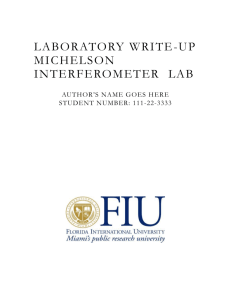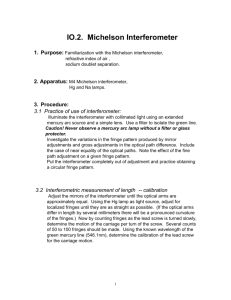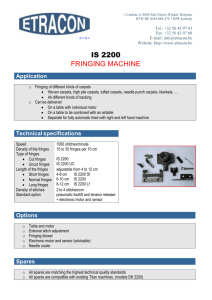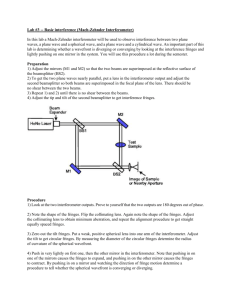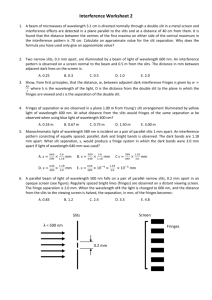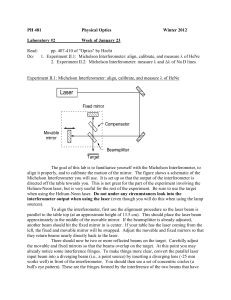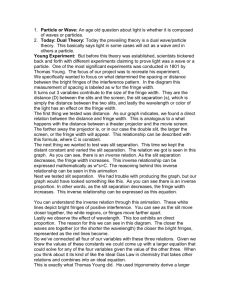The Michelson Interferometer
advertisement
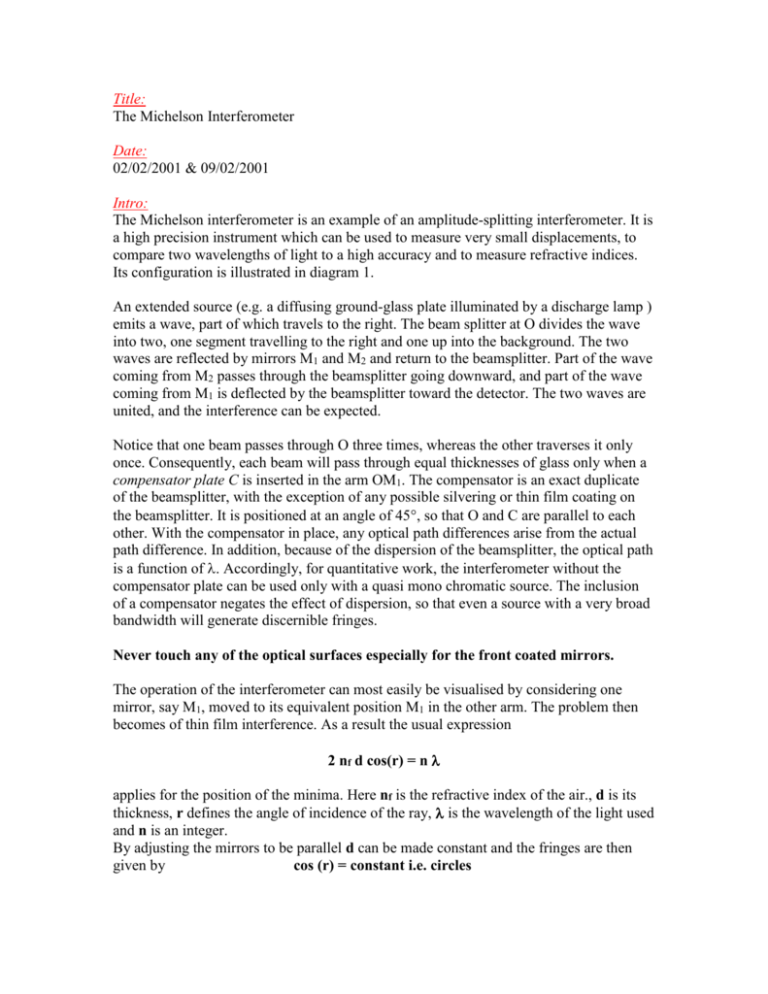
Title: The Michelson Interferometer Date: 02/02/2001 & 09/02/2001 Intro: The Michelson interferometer is an example of an amplitude-splitting interferometer. It is a high precision instrument which can be used to measure very small displacements, to compare two wavelengths of light to a high accuracy and to measure refractive indices. Its configuration is illustrated in diagram 1. An extended source (e.g. a diffusing ground-glass plate illuminated by a discharge lamp ) emits a wave, part of which travels to the right. The beam splitter at O divides the wave into two, one segment travelling to the right and one up into the background. The two waves are reflected by mirrors M1 and M2 and return to the beamsplitter. Part of the wave coming from M2 passes through the beamsplitter going downward, and part of the wave coming from M1 is deflected by the beamsplitter toward the detector. The two waves are united, and the interference can be expected. Notice that one beam passes through O three times, whereas the other traverses it only once. Consequently, each beam will pass through equal thicknesses of glass only when a compensator plate C is inserted in the arm OM1. The compensator is an exact duplicate of the beamsplitter, with the exception of any possible silvering or thin film coating on the beamsplitter. It is positioned at an angle of 45, so that O and C are parallel to each other. With the compensator in place, any optical path differences arise from the actual path difference. In addition, because of the dispersion of the beamsplitter, the optical path is a function of . Accordingly, for quantitative work, the interferometer without the compensator plate can be used only with a quasi mono chromatic source. The inclusion of a compensator negates the effect of dispersion, so that even a source with a very broad bandwidth will generate discernible fringes. Never touch any of the optical surfaces especially for the front coated mirrors. The operation of the interferometer can most easily be visualised by considering one mirror, say M1, moved to its equivalent position M1 in the other arm. The problem then becomes of thin film interference. As a result the usual expression 2 nf d cos(r) = n applies for the position of the minima. Here nf is the refractive index of the air., d is its thickness, r defines the angle of incidence of the ray, is the wavelength of the light used and n is an integer. By adjusting the mirrors to be parallel d can be made constant and the fringes are then given by cos (r) = constant i.e. circles By tilting the adjusting screws on M1 to produce a wedge shaped air film one obtains fringes corresponding to d = constant. It is such vertical parallel straight line fringes that will prove most useful for the experiments that will be performed. Setting up: 1. To observe the fringes, all the mirrors must be reasonably parallel to each other. We shall use ordinary geometrical methods to make this coarse adjustment. 2. Turn on the Hg lamp. Ensure the metal pointer is clipped on to the diffusing screen in front of the lamp housing in a 12 o’ clock position. Align your eye with the viewing axis about 25cm from the instrument. Two reflected images of the pointer should then be visible, and by adjusting the tilt controls on the mirror M1 those images can be superimposed. 3. By further adjustment, vertical straight fringes were produced with about nine of them in the field of view. 4. The instrument is ready but we preferred to operate near the apex of the air wedge. We used the white light source which produced an interference pattern of a few coloured fringes surrounding a central black fringe and the zero order fringe is thus readily identifiable. This is because in the formula 2 nf d cos(r) = n , r now equals zero. Method: Part 1: Measurement of refractive index of air For this experiment, we will use the mercury lamp with a mercury green filter to isolate the line of 546 nm wavelength, and of course parallel fringes in the interferometer. The idea is to remove the air from the cell and note the number of fringes which pass across the field of view. If this number is h then 2 l ( na – L ) = h where L is the length of cell, is the wavelength of light used, and na the refractive index of air which we want. The cell was pumped out completely, and the air was slowly leaked back in, while at the same time the fringes were counted. The procedure is then to switch on the rotary pump, close the valve near its outlet, and slowly open the clip on the pump-out tube to the cell. The pressure gauge quickly reached –1 bar, when the clip on the cell pump out tube can be closed. Care must be taken when using the rotary pump. Be sure the chain of events above happens in that order, else oil could be sucked back from the pump into the cell. The cut-off clip on the leak tube can now be opened. The number of fringes passing the image of the pointer, as the pressure returns to atmospheric was counted. To ensure accuracy, keep head in a fixed position. The pressure need not be noted exactly so long as the pressure outside the cell is greater than the pressure inside the cell. If it is not, the air will not rush in thus giving us the fringes we want to count. The ambient temperature need not be measured, once it can be assumed to a high degree of accuracy that the experiment is not carried out a temperature close to absolute zero (being within a degree thereof!) Results: Part 1: Measurement of refractive index of air To derive the formula 2 d cos = h consider diagram 2. An observer at the position of the detector will simultaneously see both mirrors M1 and M2 along with the source in the beamsplitter. One can now redraw the interferometer as if all the elements were in a straight line. Here M1’ corresponds to the image of mirror M1 in the beamsplitter and, has been swung over in line with O and M2. The positions of these elements in the diagram depend on their relative distances from O (e.g. M1’ can be in front of, behind, or coincident with M2 and can ever pass through it ). The surfaces 1 and 2 are the images of the source in mirrors M1 and M2, respectively. Now consider a single point S on the source emitting light in all directions; let’s follow the course of one emerging ray. In fact, a wave from S will be split at O, and its segments will thereafter be reflected from M1 and M2. In my diagram I represent this by reflecting the ray off both M2 and M1’. To an observer at D, the two reflected rays will appear to have come from the image points S1 and S2. As the figure shows, the optical path difference for these rays is nearly 2 d cos , which represents a phase difference of k02d cos . There is an additional phase term arising from the fact that the wave traversing the arm OM2 is internally reflected in the beamsplitter, whereas the OM1 wave is externally reflected at O. Destructive, rather than constructive, interference will then exist when 2 d cos = h where h is an integer. cos = na - 1 ******************* Part (a): 1st time: Number of fringes counted: 2nd time: 36 +/ 1 36 +/ 1 na = ( h / 2 L ) + 1 na = ( 36 * 5.46 * 10 –7 ) / ( 2 * 0.05 ) + 1 na = 1.0 +/- 0.0 Part (b): Micrometer when centred on zeroth order fringe read 3.84 mm. 34 fringes had passed when micrometer read 4.24 mm 1 fringe = 0.01 mm +/- 0.01 mm by separate calibration. na = ( h / 2 L ) + 1 na = ( 34 * 5.46 * 10 –7 ) / ( 2 * 0.05 ) + 1 na = 1.0 +/- 0.0 Part (c): % of atmospheric pressure 10 % +/-2 % 20 % +/-2 % 30 % +/-2 % 40 % +/-2 % Pressure in bars -0.1 +/- 0.02 -0.2 +/- 0.02 -0.3 +/- 0.02 -0.4 +/- 0.02 No. of fringes on 1st count 5 +/- 0.5 11 +/- 0.5 13 +/- 0.5 18 +/- 0.5 No. 2 of fringes on 2nd count 6 +/- 0.5 10 +/- 0.5 15 +/- 0.5 19 +/- 0.5 Average number of fringes 5.5 +/- 0.5 10.5 +/- 0.5 14.0 +/- 0.5 18.5 +/- 0.5 50 % +/-2 % -0.5 +/- 0.02 22 +/- 0.5 24 +/- 0.5 23.0 +/- 0.5 60 % +/-2 % -0.6 +/- 0.02 26 +/- 0.5 28 +/- 0.5 27.0 +/- 0.5 70 % +/-2 % -0.7 +/- 0.02 34 +/- 0.5 32 +/- 0.5 33.0 +/- 0.5 80 % +/-2 % -0.8 +/- 0.02 37 +/- 0.5 38 +/- 0.5 37.5 +/- 0.5 90 % +/-2 % -0.9 +/- 0.02 44 +/- 0.5 44 +/- 0.5 44.0 +/- 0.5 100 % +/-2 % -1.0 +/- 0.02 54 +/- 0.5 51 +/- 0.5 52.5 +/- 0.5 A number proportional to (na – 1 ) is (2 L / m ) 2L / m +/- 10-6 3.003 * 10-5 5.733 * 10-5 7.644 * 10-5 10.101 * 10-5 12.558 * 10-5 14.742 * 10-5 18.018 * 10-5 20.475 * 10-5 24.024 * 10-5 28.665 * 10-5 Na - 1 Versus Pressure y = -0.0003x - 5E-06 R2 = 0.9879 0.00035 0.0003 0.00025 0.0002 0.00015 0.0001 0.00005 0 -1.5 -1 -0.5 0 0.5 -0.00005 Pressure - 1 bar As the pressure increases, the medium, the air, is becoming more dense. As a result, it takes light longer to pass through pressurised air than air at atmospheric pressure. This increases the refractive index of air and hence we can derive that the pressure and the refractive index of air are proportional to one another. Increase pressure, increase refractive index of air. Part 2: Wavelength Measurements Part (a) Doublet Spacing Method: The Michelson interferometer provides a very simple way of determining the wavelength difference of a doublet, provided the average wavelength is known. Therefore: ( / ) = (1 / 2 n ) The fringes appear again at higher values of n, and clearly we move from the zeroth order fringe the next maximum of visibility we have: ( / ) = ( 1 / n ) This formula also applied between successive minima of visibility, which is what we will determine. Use the mercury lamp with a mercury filter. Using the micrometer, obtain the readings corresponding to moving from the first minimum of visibility to the second. By calibrating the micrometer readings in terms of the fringe spacing as before, one can obtain athe value for n and hence, assuming the value for , determine . Results: Part (a) Doublet Spacing The pattern seen in the interferometer will be the result of superimposing two fringe patterns of nearly equal spacing. The resulting fringes will at first be sharp, but as we move out from the zero order fringe the system gradually gave way to a uniform brightness when the two contributing fringe sets are interlaced. This is given by: , n( + ) = ( n + ½ ) where n is the order of the fringe at disappearance and is the wavelength difference. From diagram 2, as the moveable mirror is displaced by / 2, each fringe will move to the position previously occupied by an adjacent fringe. One need only count the number of fringes n, or portions thereof, that have moved past a reference point to determine the distance travelled by the mirror d, that is, d = n ( / 2 ) where d = (n / 2) at the zeroth fringe Micrometer reading before experiment = 3.84 mm +/- 0.01 mm Micrometer reading after experiment = 5.05 mm +/- 0.01 mm Difference = 1.21 mm +/- 0.01 mm 1 fringe = 0.01 mm +/- 0.01 mm n = 121 +/- 121 -7 = / n = 5.46 * 10 / 121 = 4 nm +/- 4 nm Part (b) Filter band pass Method: In the previous experiment we were concerned with a light source having just the two very closely spaced wavelengths and we obtained a pattern with visibility maxima and minima in the fringes. If white light is now used with a band of wavelengths present then it is not difficult to see that the visibility will decrease from the zero order fringe to a minimum, but the fringes will not reappear thereafter. However, the formula ( / ) = (1 / 2 n ) can still be used to estimate the half width of the filter, n being the number of fringes between the zero order and disappearance. Using the green filter (max = 546 nm) and the white light source, count the total number of fringes visible. This gives 2n straight away, and hence an idea of the wavelength band passed. 2n = 19 +/- 1 fringes. = / 19 = 28 +/- 2 nm --------------------------Paul Walsh – 2001 pwalsht@maths.tcd.ie

